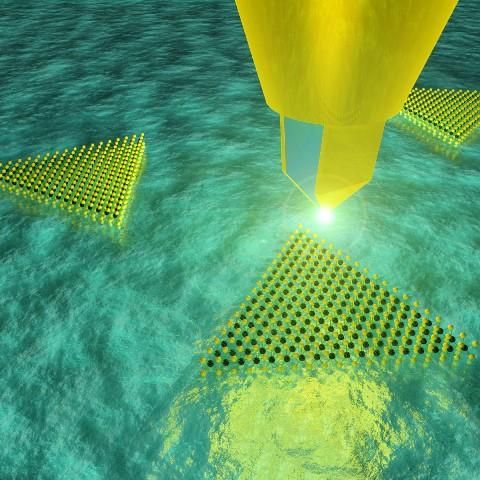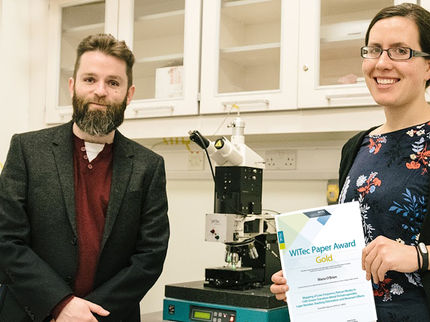Surprising discoveries about 2-D molybdenum disulfide
Berkeley Lab researchers use campanile probe on promising semiconductor
Scientists with the U.S. Department of Energy (DOE)'s Lawrence Berkeley National Laboratory (Berkeley Lab) have used a nano-optical probe to study the effects of illumination on two-dimensional semiconductors at the molecular level. Working at the Molecular Foundry, a DOE Office of Science User Facility, the scientific team used the "Campanile" probe they developed to make some surprising discoveries about molybdenum disulfide, a member of a family of semiconductors, called "transition metal dichalcogenides (TMDCs), whose optoelectronic properties hold great promise for future nanoelectronic and photonic devices.

With the Campanile probe, optical excitation and collection are spatially confined to the nano-sized gap at the apex of the tip, which is scanned over the sample, recording a full emission spectrum at each position
James Schuck, Berkeley Lab
"The Campanile probe's remarkable resolution enabled us to identify significant nanoscale optoelectronic heterogeneity in the interior regions of monolayer crystals of molybdenum disulfide, and an unexpected, approximately 300 nanometer wide, energetically disordered edge region," says James Schuck, a staff scientist with Berkeley Lab's Materials Sciences Division. Schuck led this study as well as the team that created the Campanile probe, which combines the advantages of scan/probe microscopy and optical spectroscopy.
"This disordered edge region, which has never been seen before, could be extremely important for any devices in which one wants to make electrical contacts," Schuck says. "It might also prove critical to photocatalytic and nonlinear optical conversion applications."
2D-TMDCs rival graphene as potential successors to silicon for the next generation of high-speed electronics. Only a single molecule in thickness, these materials boast superior energy efficiencies and a capacity to carry much higher current densities than silicon.
In this study, Schuck and his colleagues also discovered that the disordered edge region in molybdenum disulfide crystals harbors a sulfur deficiency that holds implications for future optoelectronic applications of this 2D-TMDC.
"Less sulfur means more free electrons are present in that edge region, which could lead to enhanced non-radiative recombination," Schuck says. "Enhanced non-radiative recombination means that excitons created near a sulfur vacancy would live for a much shorter period of time."
However, since their experimental "discovery" in 2010, the performance of 2D-TMDC materials has lagged far behind theoretical expectations primarily because of a lack of understanding of 2D-TMDC properties at the nanoscale, particularly their excitonic properties.
"The poor understanding of 2D-TMDC excitonic and other properties at the nanoscale is rooted in large part to the existing constraints on nanospectroscopic imaging," Schuck says. "With our Campanile probe, we overcome nearly all previous limitations of near-field microscopy and are able to map critical chemical and optical properties and processes at their native length scales."
Original publication
Other news from the department science

Get the analytics and lab tech industry in your inbox
By submitting this form you agree that LUMITOS AG will send you the newsletter(s) selected above by email. Your data will not be passed on to third parties. Your data will be stored and processed in accordance with our data protection regulations. LUMITOS may contact you by email for the purpose of advertising or market and opinion surveys. You can revoke your consent at any time without giving reasons to LUMITOS AG, Ernst-Augustin-Str. 2, 12489 Berlin, Germany or by e-mail at revoke@lumitos.com with effect for the future. In addition, each email contains a link to unsubscribe from the corresponding newsletter.

























































